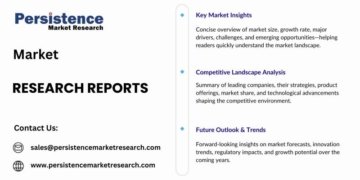The global spatial computing market is rapidly evolving as companies seek innovative solutions to bridge the physical and digital worlds. As digital transformation intensifies across industries, spatial computing has emerged as a game-changing technology that digitizes real-world interactions between humans, machines, and environments. This convergence of physical and virtual realities is unlocking unprecedented business potential.
By integrating technologies like augmented reality (AR), virtual reality (VR), artificial intelligence (AI), and IoT, spatial computing allows real-time interaction in 3D environments. Whether optimizing workflows in a warehouse or enhancing the user experience in retail and entertainment, the applications of spatial computing are expanding rapidly across sectors. With high demand for smarter systems and immersive experiences, the market continues to gain significant momentum.
Get a Sample PDF Brochure of the Report (Use Corporate Email ID for a Quick Response): www.persistencemarketresearch.com/samples/32998
✅Overview of the Market
The spatial computing market has shown consistent growth over the past few years, with strong indicators pointing to continued expansion. One of the primary catalysts is the need to streamline machine-to-machine and human-machine interactions, particularly in industrial and enterprise environments.
Healthcare, manufacturing, automotive, and education sectors are leading adopters of spatial technologies. Among all the segments, healthcare is poised to register the highest growth rate owing to its impact on surgical precision, diagnostics, and remote treatment. North America, especially the U.S., leads the market in terms of adoption, supported by the presence of major tech giants and a high rate of technological innovation.
✅Key Highlights from the Report:
➤ Spatial computing integrates AR, VR, AI, and IoT to enhance real-world interactions.
➤ Healthcare is the fastest-growing segment, driven by need for precision and improved outcomes.
➤ North America remains the dominant market due to high adoption rates and tech innovation.
➤ Enterprises are using spatial computing to reduce operational costs and downtime.
➤ Investments in immersive tech and 3D mapping are increasing across industries.
➤ Leading companies are forming strategic alliances to scale XR and cloud-based applications.
✅Market Segmentation
The spatial computing market can be segmented based on industry, product type, and end-user applications. By industry, the market spans healthcare, transport, education, manufacturing, automotive, entertainment, and others. Among these, healthcare stands out for its transformative use in diagnostics, surgical planning, and patient rehabilitation. Manufacturing follows closely, leveraging spatial computing to enhance automation, quality control, and workforce training.
By product type and user applications, the market includes head-mounted displays, smart glasses, spatial sensors, and software platforms. End-users range from enterprises and hospitals to educational institutions and entertainment providers. The increasing accessibility of smart wearable devices is contributing significantly to the democratization of spatial computing technology across these segments.
✅Regional Insights
In North America, especially the United States, spatial computing adoption is being driven by major players like Microsoft, Google, and Magic Leap. The region’s advanced infrastructure, tech-savvy population, and early embrace of emerging technologies position it as a market leader.
Europe is also showing strong traction, with countries like Germany, the UK, and France heavily investing in AR/VR research, IoT deployments, and digital transformation initiatives. Growth is further supported by increased government and private sector spending on immersive tech solutions.
✅Market Drivers
One of the strongest drivers of the spatial computing market is the urgent need for improved interaction between humans and machines in real-time environments. Enterprises are looking to reduce costs, improve productivity, and enhance safety across sectors like manufacturing, logistics, and healthcare. The rise of remote collaboration tools and immersive training methods further fuels demand.
In addition, the proliferation of smart devices and 5G infrastructure enables faster data transmission and real-time responsiveness, making spatial computing applications more viable and scalable. Businesses are also increasingly recognizing the role of spatial computing in enhancing customer experiences, from virtual try-ons to immersive shopping.
✅Market Restraints
Despite its promising potential, the market faces several challenges. A significant restraint is the lack of skilled professionals with expertise in immersive technologies, spatial programming, and system integration. This talent gap slows down implementation and innovation.
Moreover, the high cost and complexity of spatial computing systems can deter small and medium-sized enterprises from early adoption. Regulatory concerns, data privacy issues, and limited standardization across platforms further complicate deployment in sensitive industries such as healthcare and defense.
✅Market Opportunities
Emerging economies offer immense potential for spatial computing as industries there begin to embrace automation and digital transformation. With growing interest in smart cities and connected infrastructure, spatial computing can play a key role in planning, maintenance, and public safety.
Education and training are other areas with vast growth potential. Immersive learning tools powered by spatial computing are revolutionizing how knowledge is delivered, especially in technical fields and remote environments. As more industries recognize its value, opportunities for partnerships, product development, and service expansion will continue to grow.
✅Reasons to Buy the Report:
☑Gain deep insights into market trends, drivers, and growth forecasts
☑Understand competitive dynamics and strategies of leading players
☑Identify emerging opportunities in high-growth regions and sectors
☑Access segment-level analysis for informed decision-making
☑Stay ahead with data-driven insights on key technological developments
✅Frequently Asked Questions (FAQs):
➤How Big is the Spatial Computing Market?
➤Who are the Key Players in the Global Spatial Computing Market?
➤What is the Projected Growth Rate of the Spatial Computing Market?
➤What is the Market Forecast for Spatial Computing through 2031?
➤Which Region is Estimated to Dominate the Industry through the Forecast Period?
✅Company Insights
✦Microsoft Corporation
✦Google Inc.
✦Facebook
✦Magic Leap
✦Amazon.com Inc.
✦Vuforia
✦Ford
✦IBM Corporation
✦Uber
■ In October 2021, Magic Leap partnered with VMware to integrate the ‘Workspace ONE XR Hub’ into Magic Leap 2, advancing enterprise XR applications.
■ In January 2021, Magic Leap teamed up with Google Cloud to develop spatial computing solutions to support business agility and continuity.
Contact Us:
Persistence Market Research
G04 Golden Mile House, Clayponds Lane
Brentford, London, TW8 0GU UK
USA Phone: +1 646-878-6329
UK Phone: +44 203-837-5656
Email: sales@persistencemarketresearch.com
Web: https://www.persistencemarketresearch.com
About Persistence Market Research:
At Persistence Market Research, we specialize in creating research studies that serve as strategic tools for driving business growth. Established as a proprietary firm in 2012, we have evolved into a registered company in England and Wales in 2023 under the name Persistence Research & Consultancy Services Ltd. With a solid foundation, we have completed over 3600 custom and syndicate market research projects, and delivered more than 2700 projects for other leading market research companies’ clients.
Our approach combines traditional market research methods with modern tools to offer comprehensive research solutions. With a decade of experience, we pride ourselves on deriving actionable insights from data to help businesses stay ahead of the competition. Our client base spans multinational corporations, leading consulting firms, investment funds, and government departments. A significant portion of our sales comes from repeat clients, a testament to the value and trust we’ve built over the years.
This release was published on openPR.


















